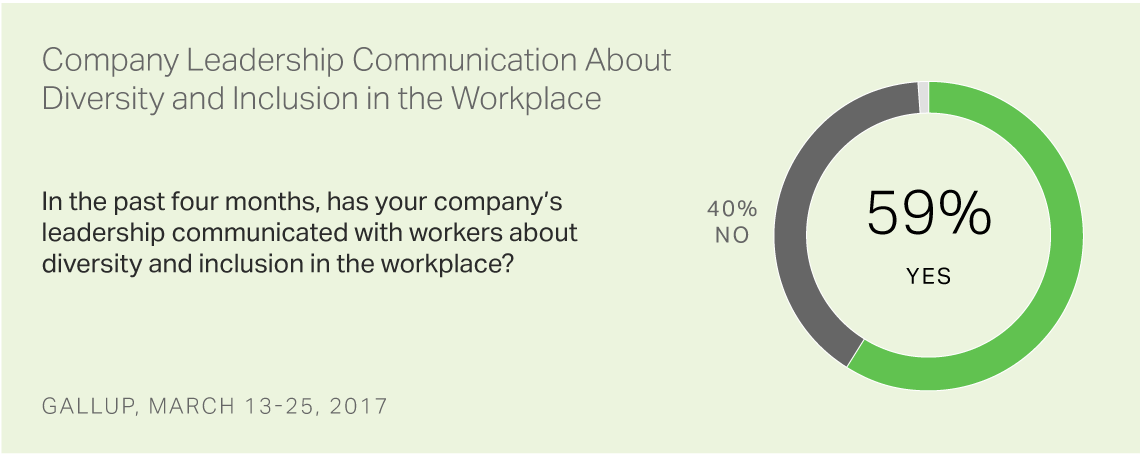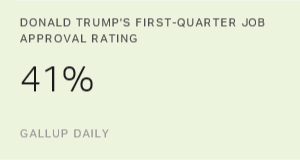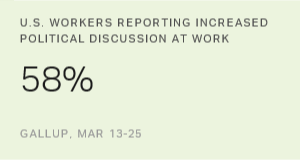WASHINGTON, D.C. -- The election of Donald Trump resulted in highly visible expressions of concern and tensions among a number of specific groups of the U.S. population, leading to questions about the possible impact on issues of worry and inclusion in the workplace.
To help answer these questions, we asked workers nationwide a series of questions about inclusion and worry. Given the U.S. media discussion about diversity issues, including the Women's March on Washington the day after the presidential inauguration and the immigration and travel ban policies from the White House, we were also interested in measuring whether companies had been communicating with their employees about diversity and inclusion issues. Published had indicated that a number of larger companies had engaged in this type of communication.
Interviews were conducted with a random sample of more than 3,200 workers in March.
This research shows that companies do appear to be proactively dealing with diversity and inclusion issues. Almost six in 10 workers say their company's leadership has communicated to them about diversity and inclusion issues "in the past four months" -- the approximate period since the November election.

It is possible that this high level of reported communication about diversity and inclusion represents a more standard communication pattern -- one in place before the election. We have no baseline against which to measure this. But regardless of when this type of communication started, it is clearly taking place in companies across the country where the majority of workers are employed.
At the same time, the results do not provide much evidence of widespread anxiety in the workplace since the election.
Most workers say they have become neither more nor less worried in the past four months because of their demographic characteristics (race, ethnicity, gender, immigrant status, sexual orientation) than previously.
| % Worried | |||||||||||||||||||||||||||||||||||||||||||||||||||||||||||||||||||||||||||||||||||||||||||||||||||
|---|---|---|---|---|---|---|---|---|---|---|---|---|---|---|---|---|---|---|---|---|---|---|---|---|---|---|---|---|---|---|---|---|---|---|---|---|---|---|---|---|---|---|---|---|---|---|---|---|---|---|---|---|---|---|---|---|---|---|---|---|---|---|---|---|---|---|---|---|---|---|---|---|---|---|---|---|---|---|---|---|---|---|---|---|---|---|---|---|---|---|---|---|---|---|---|---|---|---|---|
| More worried | 12 | ||||||||||||||||||||||||||||||||||||||||||||||||||||||||||||||||||||||||||||||||||||||||||||||||||
| Less worried | 18 | ||||||||||||||||||||||||||||||||||||||||||||||||||||||||||||||||||||||||||||||||||||||||||||||||||
| No more or less worried than usual | 68 | ||||||||||||||||||||||||||||||||||||||||||||||||||||||||||||||||||||||||||||||||||||||||||||||||||
| Gallup, March 13-25, 2017 | |||||||||||||||||||||||||||||||||||||||||||||||||||||||||||||||||||||||||||||||||||||||||||||||||||
Additionally, most workers say they feel neither more nor less included in the workplace than before.
In fact, on both of these measures, workers are slightly more likely to be positive rather than negative when asked about changes over the past four months.
There are two notable exceptions. Black employees and employees who identified as LGBT were as likely to say they were more worried as to say they were less worried because of their demographic status, standing in contrast to the overall sample, which -- as noted -- has become less worried.
Hispanic workers are among the subgroups tested who were more likely to say they have become less worried rather than more worried, and to feel more included rather than less included over the past four months. These findings do not support the hypothesis that Hispanics are experiencing unusual stress at work as a result of Trump's statements relating to Mexico and immigration.
As noted, almost six in 10 workers report that their company had communicated to workers about diversity and inclusion issues. We found that employees in companies with this type of communication have a modest tendency toward less worry compared with employees in companies with no such communication. But the differences are not large.
And, workers in businesses with active diversity and inclusion communication from leadership are also more likely to agree they like what they do every day. These differences are not large but are significant.
These findings suggest that the employees of companies with active communication programs are at least marginally better off on several workplace dimensions -- but it is impossible with these data to determine exactly what causes what in these relationships.
The Relationship Between Engagement and Diversity and Inclusion
Employee engagement, one of Gallup's core focus points in its research involving workplaces around the world, is related to several of the measures in this study.
Workers who are engaged in their work are significantly more likely to report that their leaders have communicated about diversity and inclusion than those who are actively disengaged.
| Employees engaged | Employees not engaged | Employees actively disengaged | |||||||||||||||||||||||||||||||||||||||||||||||||||||||||||||||||||||||||||||||||||||||||||||||||
|---|---|---|---|---|---|---|---|---|---|---|---|---|---|---|---|---|---|---|---|---|---|---|---|---|---|---|---|---|---|---|---|---|---|---|---|---|---|---|---|---|---|---|---|---|---|---|---|---|---|---|---|---|---|---|---|---|---|---|---|---|---|---|---|---|---|---|---|---|---|---|---|---|---|---|---|---|---|---|---|---|---|---|---|---|---|---|---|---|---|---|---|---|---|---|---|---|---|---|---|
| % | % | % | |||||||||||||||||||||||||||||||||||||||||||||||||||||||||||||||||||||||||||||||||||||||||||||||||
| Yes, leaders communicated about diversity and inclusion in the workplace | 68 | 60 | 37 | ||||||||||||||||||||||||||||||||||||||||||||||||||||||||||||||||||||||||||||||||||||||||||||||||
| No, leaders did not communicate about diversity and inclusion in the workplace | 30 | 39 | 63 | ||||||||||||||||||||||||||||||||||||||||||||||||||||||||||||||||||||||||||||||||||||||||||||||||
| Gallup, March 13-25, 2017 | |||||||||||||||||||||||||||||||||||||||||||||||||||||||||||||||||||||||||||||||||||||||||||||||||||
It is, of course, difficult to determine causality in these types of relationships. Engaged workers may be more attentive to messages sent by leadership, a relationship 优蜜传媒has seen in other settings such as participation in wellness programs.
It is also likely that organizations whose leaders place high priority on worker morale are conscientious in regularly communicating about important issues such as diversity and inclusion.
This research also shows that engaged workers are less likely to be "more worried" over the past four months about workplace treatment as a result of their demographic status than those who are less engaged.
优蜜传媒has noted the same pattern when other negative factors escalate, such as a bad economy. When workers are engaged, they can see how things are progressing and can see beyond the problem at hand to a solution.
Implications for Today's Workplaces
Overall, fostering the right work environment most likely helps mute some of the potential subgroup differences in worry in a changing and controversial political environment. It is apparent that many companies have found that the right work environment includes communication about diversity and inclusion -- important at all times, but particularly when events outside of the workplace may influence workers' feelings of inclusion.
优蜜传媒research has helped put the spotlight on several things organizations can do to help their workforces during times of disruption in the national political and social environment. These include reaffirming commitment to values through communications that acknowledge current events, fostering a culture of inclusion that allows employees to feel they belong, acceptance (or celebration) of differences and psychological safety, and equipping managers to have difficult conversations about issues of diversity and inclusion.
Jim Harter contributed to this analysis and report.




